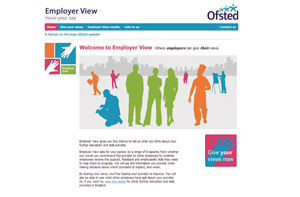Employers will be able to anonymously rate, review and compare providers using an online tool launched by Ofsted.
Employer View allows staff to share their thoughts on providers they have worked with, and find out what other employers think about any provider which trains it’s employees, apprentices and work placement or work experience staff.
The site was launched on Monday April 28 and is open to the public, but employers’ details will be kept confidential.
Ofsted national director for FE and skills Lorna Fitzjohn said: “The tool will inform inspectors’ understanding of the effectiveness of provision, increase employers’ engagement in education and training, and help them and employees to choose the provider that is right for them.”
A questionnaire on the site asks employers to rate their provider partners on the quality of their communication, monitoring of employee progress, training provision, and feedback and support.
“Employers in the past have often not been sufficiently included in the education and training of learners, including apprentices, and we recognised that this needed to change,” said Mrs Fitzjohn.
“Engagement with employers was highlighted as a major theme for improvement in Ofsted’s Annual Report and we hope Employer View will facilitate a dialogue between employers and providers.
“I therefore urge all employers using a provider inspected by Ofsted to visit the Employer View page on our website and contribute.”
A statement by Ofsted said safeguards would be in place to prevent the site from abuse, such as user registration and systems to flag signs of potential misuse, and that the site security compared well with similar public sector sites.
Mrs Fitzjohn said: “We have worked hard to make sure we strike the right balance between security and accessibility when deciding the measures to put in place.
“If a provider or employer believes information is being skewed they should let us know and we will investigate.”
The Association of Employment and Learning Providers (AELP) chief executive Stewart Segal said: “We are pleased Ofsted is giving more recognition to the views of employers.
“We have always said that the more focus we put on outcomes and views of the ultimate customers the better.”
However, he said there was already a “crowded marketplace” for information on providers.
“Employers now have a number of sources of information and support including National Apprenticeship Service website, FE Choices, Ofsted main site, Ofsted Employer Choices, Apprenticeship Makers, National Careers Services which will confuse many smaller employers,” he said.
“We are now looking at how access to these services and support can be made more effective through one single information source.”
He added: “Ofsted need to use the informal information generated by Employer Choices carefully and ensure that this is balanced with the more formal survey information already generated by training providers.
“Responses to the system will be anonymous and may not be statistically significant so there has to be a process where the information is reviewed with the provider as the responses may not be a balanced sample.”
The tool will use the same model as Learner View, which was launched in September 2012 to allow learners to rate their providers.
Visit www.employerview.ofsted.gov.uk to use Employer View.


